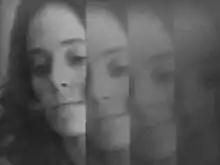Hermine Freed
Hermine Freed (May 29, 1940 New York City – November 21, 1998 New York City) was an American painter and video artist.[1] She is noted for being among the first generation of artists to explore video art in the late 1960s.[2]
Hermine Freed | |
|---|---|
 Hermine Freed in her work Two Faces | |
| Born | May 29, 1940 New York, New York |
| Died | November 21, 1998 (aged 58) New York, New York |
| Nationality | American |
| Education | Cornell University (BA, 1961), New York University (MA, 1967)[1] |
| Known for | painting, video art |
Notable work | Art Herstory (1974) |
| Spouse(s) | James Ingo Freed |
Life and work
Freed studied painting at Cornell University and New York University, where she taught starting from the late 1960s. In 1972 she became a professor for video art at the School of Visual Arts in New York.
She worked with colleague Andy Mann as a program editor for an NYU-sponsored series on art books for WNYC. Initially she filmed artist portraits, beginning with James Rosenquist, as well as Lee Krasner, Adolph Gottlieb, Robert Morris, Roy Lichtenstein, and Joyce Kozloff.[2] Although WNYC did not broadcast the portrait, she was not discouraged and produced a whole series.[3]
Apart from her documentary work she created videos that artistically negotiated female subjectivity and self-perception. In 1972 she participated in the exhibition Circuit: A Video Invitational at the Everson Museum of Art, curated by David Ross. Two Faces (1973) and Art Herstory (1974) are two of her most notable works.[4] At the time she was an artist-in-residence at the Television Lab at WNET.[3]
Solo exhibitions
- 1981 Hermine Freed–Beads & Marbles - Leo Castelli Gallery, New York City, NY
Group exhibitions
- 1977 Documenta 6, Kassel
- 1975 Projects: Video VI−MoMA, Museum of Modern Art, New York City, NY
- 1975 IX Paris Biennial, Paris
- 1975 Projections at the Whitney Museum
- 1975 Video Art at the Serpentine Gallery in London
- 1973 10th São Paulo Art Biennial
References
- Marter, Joan M., ed (2011). The Grove Encyclopedia of Art. Oxford University Press.CS1 maint: extra text: authors list (link)
- "Hermine Freed". LANDMARKS. 2017-08-16. Retrieved 2020-12-29.
- "Hermine Freed | Video Data Bank". www.vdb.org. Retrieved 2020-12-29.
- Art-Herstory Hermine Freed Archived 2013-12-31 at the Wayback Machine